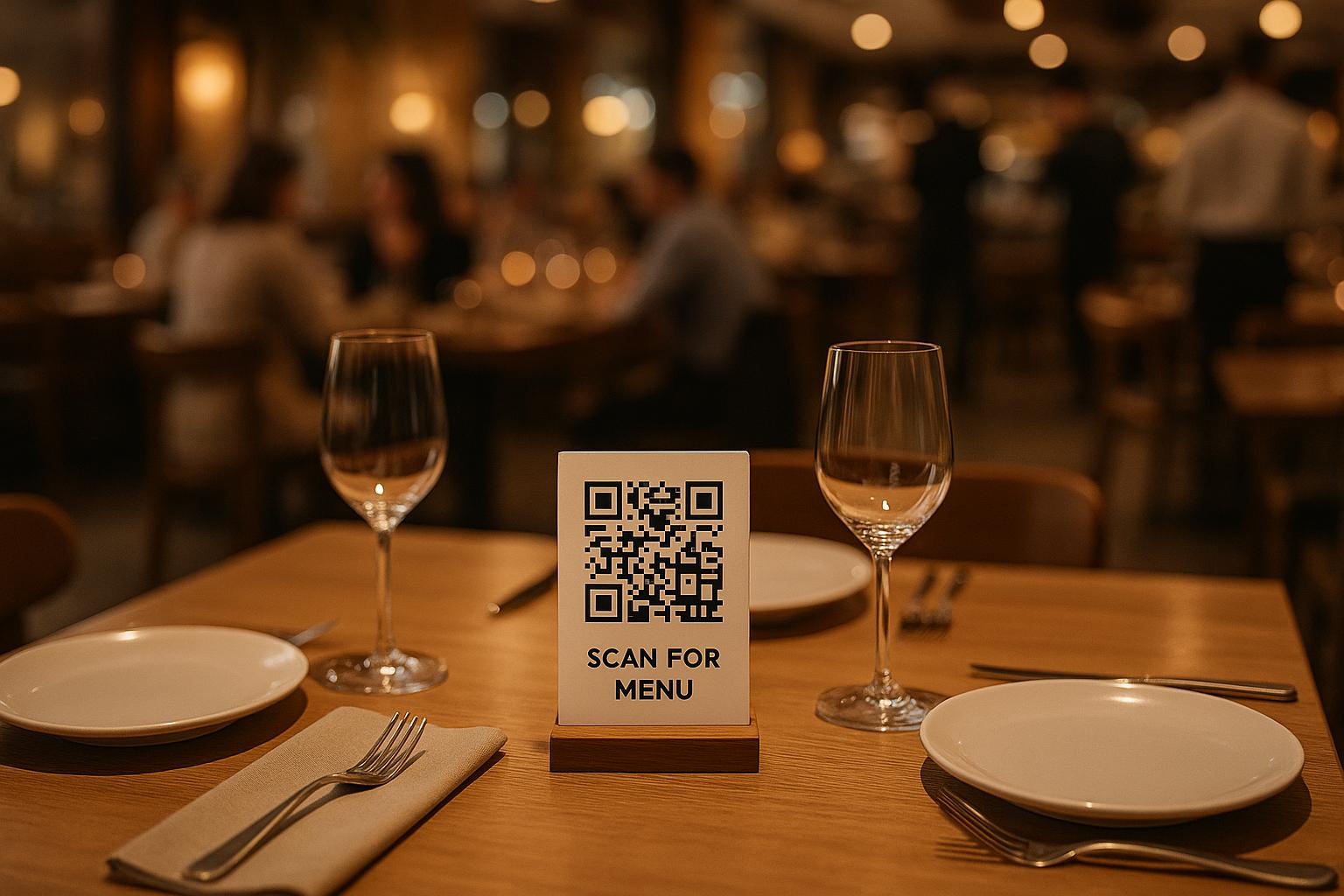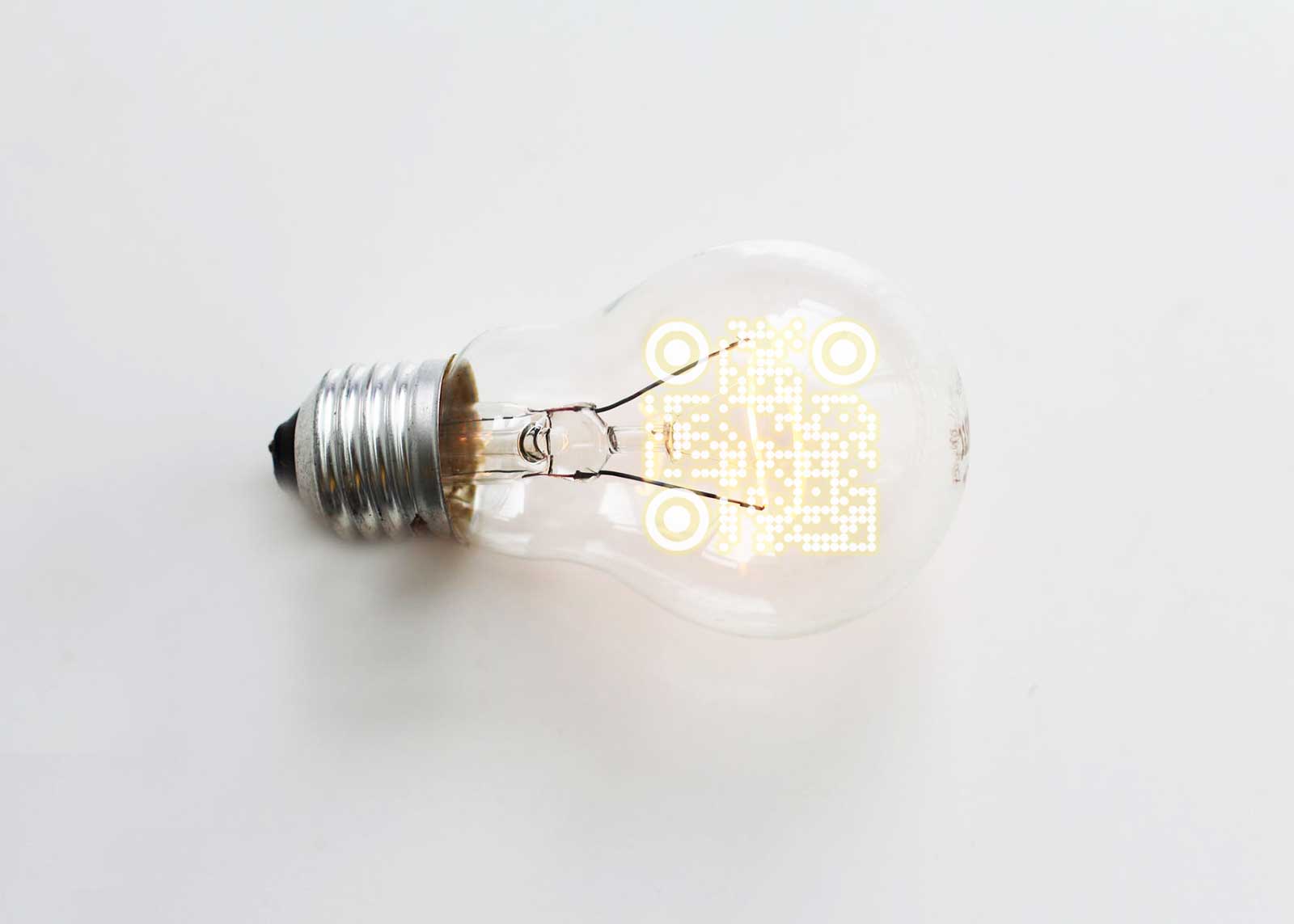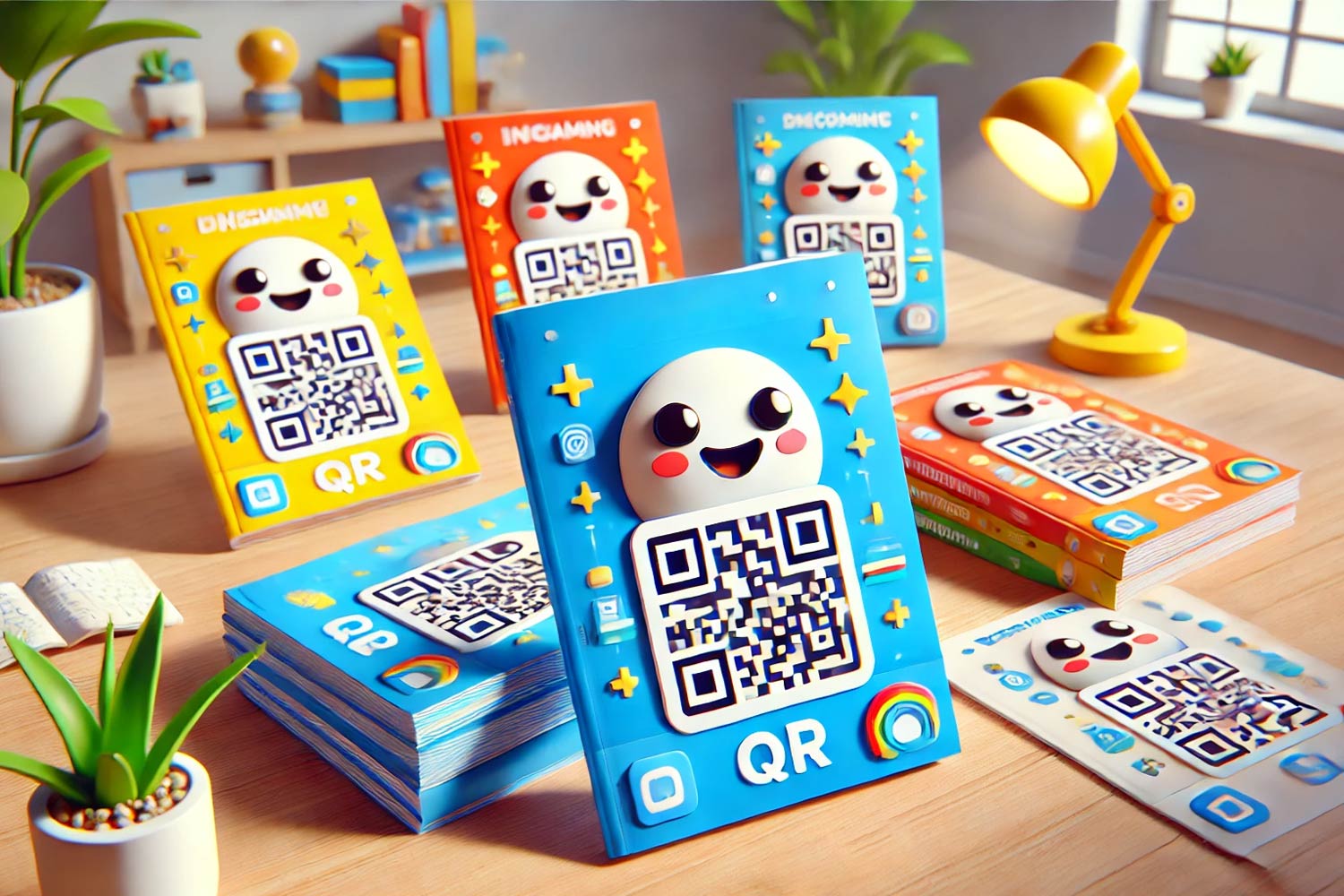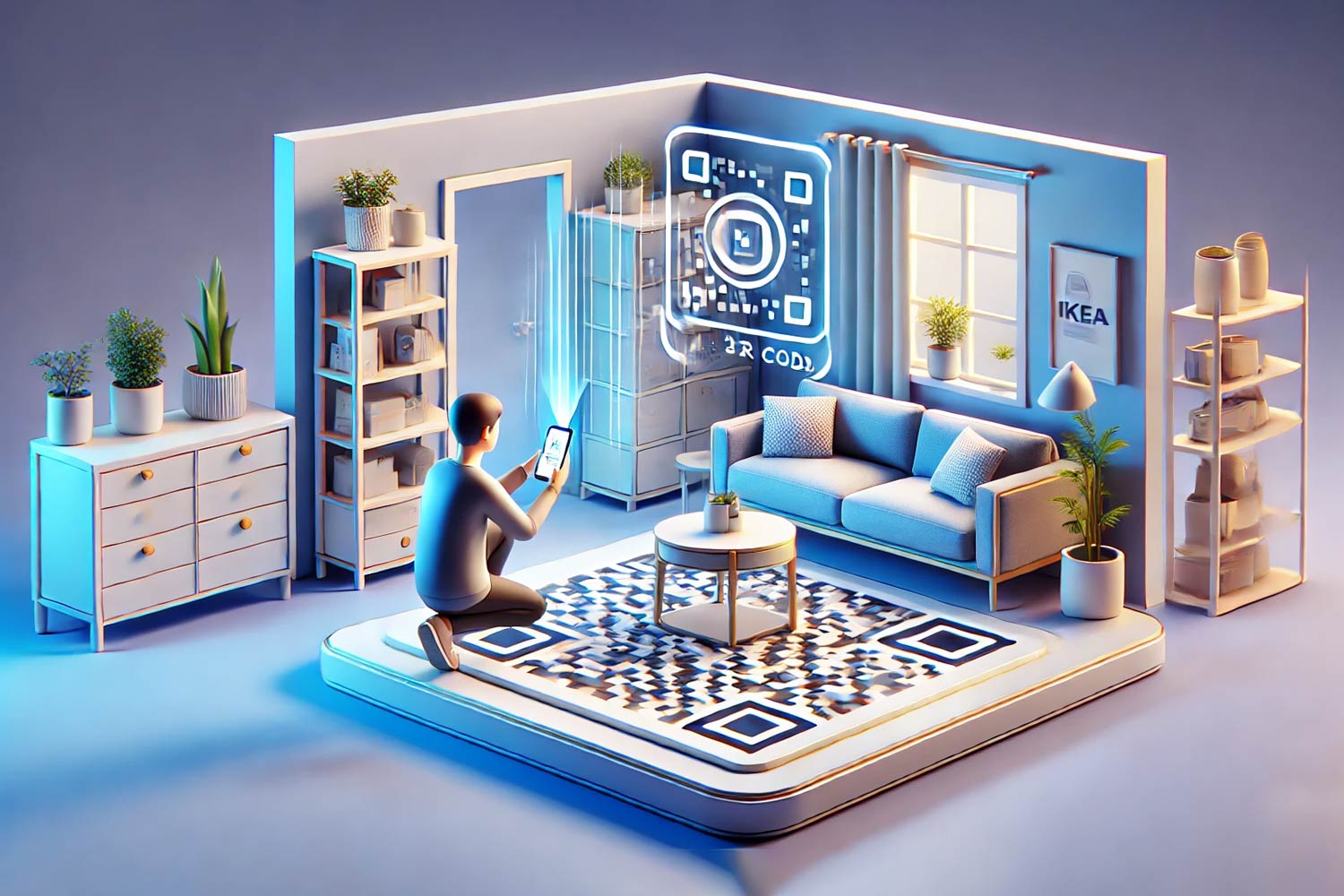QR codes make table reservations faster, easier, and more efficient for both diners and restaurants. By scanning a code, customers can instantly check availability and book a table without phone calls or waiting. Restaurants benefit from reduced booking errors, streamlined operations, and valuable data insights.
Key Takeaways:
- Convenience for diners: Book anytime, anywhere with just a smartphone.
- Efficiency for staff: Reduce phone calls and errors while focusing on service.
- Boost in revenue: QR code systems have increased restaurant earnings by thousands of dollars monthly.
- Dynamic QR codes: Update links without reprinting, saving time and costs.
- Strategic placement: Place codes on tables, menus, or posters for maximum visibility.
QR codes are transforming the dining experience, offering speed, simplicity, and improved service for everyone involved.
Step-by-step guide to setting up QR code reservations
Creating a QR code for reservations
The first step is to choose a reliable tool to create a QR code that links directly to your reservation system. Platforms like Pageloot offer options for crafting QR codes tailored specifically for table reservations. It’s a simple process: select the link QR code type, then input the URL of your reservation platform – whether that’s OpenTable, Resy, or a custom booking page for your restaurant.
To make your QR code stand out and build trust, customize it with your logo, brand colors, and a frame that matches your restaurant’s style. Branded QR codes not only look professional but also help customers associate them with your business.
When setting up your QR code, you’ll need to decide between static and dynamic options. Dynamic QR codes are a smart choice because they let you update the link without needing to reprint the code. This flexibility is especially useful if you need to change your reservation link or switch to a different platform.
Some systems, like OpenTable, even offer built-in QR code generation, which makes the process even easier. These codes can be tailored for different purposes and remain active as long as the reservation URL stays valid.
Once your QR code is ready, the next step is to place it where it will catch your customers’ attention.
Placing QR codes in your restaurant
Where you place your QR codes can significantly impact how often they’re used. For tables, consider using laminated plastic stands to protect the codes from spills and wear.
Position your QR codes in well-lit, high-traffic areas where they’re easy to spot. Ideal locations include tables, entrances, or even marketing materials like flyers and posters. As highlighted by sundayapp.com:
"Eye-level placement: Don’t make diners search for your QR codes. They should be easily visible, whether on tabletop stands or a tasteful sticker next to each seat." – sundayapp.com
In darker settings, opt for fluorescent or glow-in-the-dark backgrounds to ensure the codes remain visible. For scanning from a distance, follow a simple rule: add 0.4 inches to both the length and width of the QR code for every 4 inches of scanning distance.
Clear instructions are key to encouraging customers to use the QR codes. Include straightforward text like "Scan to make a reservation" or "Point your camera here to book a table." And don’t forget to consider your audience – always provide a traditional booking option for those who prefer it.
With the QR codes strategically placed, the next step is integrating them with your reservation system for a seamless customer experience.
Connecting QR codes with reservation systems
Integrating QR codes with your reservation system ensures instant bookings and real-time availability, making the process smooth for both customers and staff. Link your codes to platforms that show live availability and allow immediate table reservations. This eliminates the hassle of phone calls during busy hours or the disappointment of arriving to find no open tables.
Integration offers several benefits: real-time bookings, instant confirmations, and data collection. It also reduces staff errors and prevents duplicate entries when synced with your POS system. Automated updates to your management tools further simplify operations.
QR code reservations also provide valuable insights into customer habits, such as booking preferences and peak times. This data can help you fine-tune staffing, menu planning, and marketing strategies.
It’s essential to train your team to assist customers with QR code scanning and address any issues that might arise. When staff members are confident and helpful, customers are more likely to embrace the technology.
One example of effective QR code integration comes from John F. Kennedy International Airport, which uses QR codes for security check reservations. Travelers can make virtual bookings and get QR codes for faster processing. While this isn’t a restaurant-specific case, it demonstrates how QR codes can streamline high-traffic operations – exactly what busy restaurants need during peak hours.
Key benefits of QR code reservations for customers and staff
Benefits for customers
QR code reservations make dining easier and more convenient. One standout perk is that customers can book a table anytime – day or night – thanks to 24/7 availability. Unlike traditional phone reservations, which are limited to business hours, diners can make plans during a lunch break, late at night, or even early in the morning.
The process itself is straightforward. Instead of dealing with busy phone lines or waiting on hold, customers can simply scan a code and reserve their table in under a minute. This ease is reflected in recent trends, with nearly half of diners (47%) now preferring to book online or through social media platforms.
Booking in advance also means no surprises – customers know their table will be ready when they arrive. Plus, the contactless nature of QR code reservations offers added reassurance for those who prioritize health and hygiene. There’s no need to handle shared menus or surfaces. On top of that, QR codes can give diners access to detailed menu information, including nutritional content and allergy warnings, even before they step into the restaurant.
Benefits for restaurant staff
While customers enjoy convenience, restaurant staff benefit from smoother operations. QR code reservations help streamline workflows, reduce wait times, and even boost revenue. By letting diners handle their own bookings, front-of-house staff can focus on welcoming guests and delivering top-notch service.
Restaurants have also seen financial gains. For instance, check averages can increase by $2–4 (around 12%) when guests use digital ordering systems. A real-world example? The Boston Hilton Downtown reported a 30% improvement in efficiency within just three months of adopting QR code reservations.
These systems also tackle common service challenges. Guests who might have waited 15 to 20 minutes for their check now experience faster service, leading to higher satisfaction. Order accuracy improves, too, as customers input their own details, reducing errors and miscommunications. On top of that, restaurants gain access to more valuable data – up to five times more first-party data compared to traditional methods. Switching to digital menus can also save medium-sized establishments about $5,000 annually.
"Get creative, not complacent. These strategies will not only boost efficiencies and optimize operations, but also significantly enhance the guest experience and ensure your customers leave wanting more."
– Stuart Lachovsky, Vice President of Sales and Strategic Partnerships, Libro
Customizable and dynamic QR codes
Beyond the basics, dynamic QR codes take the benefits to another level. Unlike static codes, which are tied to a single link, dynamic QR codes allow updates without needing to reprint materials. Restaurants can adjust reservation links, highlight special offers, or switch booking platforms instantly.
Customization adds another layer of value. By incorporating brand colors and logos into QR codes, restaurants can create a polished, professional look that builds trust with customers. Dynamic codes also provide deeper insights, such as tracking customer behavior and identifying peak booking times.
For restaurants looking to gather feedback, QR codes offer a simple solution. Since 74% of customers read multiple reviews before making a decision, linking these codes to surveys or review requests can help capture testimonials that drive future business. QR codes can also promote special deals, events, or limited-time offers, giving restaurants the flexibility to update campaigns during slow periods without reprinting materials.
Platforms like Pageloot make the process even easier. With tools for advanced customization, real-time analytics, and the ability to edit QR code content instantly, creating a QR code that aligns with your restaurant’s branding and goals has never been simpler.
Advanced QR Code Features and Applications
Using Dynamic QR Codes for Flexibility
Dynamic QR codes offer a powerful way to streamline table reservations and promotions by allowing real-time link updates. This means restaurants can keep their offerings current, even during busy periods or special events. Considering that 66% of guests make reservations on the same day they plan to dine, having a system that can adapt quickly is crucial. These codes not only ensure guests see the latest promotions but also allow for personalized experiences tailored to their preferences.
Dynamic QR codes also help restaurants save on printing costs while promoting limited-time specials. Since 68% of diners are more inclined to book when a restaurant advertises a time-sensitive offer, these codes make it easy to highlight flash sales or last-minute availability without needing to reprint materials.
To increase scan rates, engaging prompts can make all the difference. Instead of a generic "Scan here", restaurants can try phrases like "Don’t keep your taste buds waiting – reserve your table today!" or "Your perfect table is just a scan away!". This approach, combined with detailed analytics, helps restaurants refine their strategies and improve customer engagement.
Using Analytics for Data-Driven Decisions
Dynamic QR codes don’t just enhance flexibility – they also provide valuable analytics that help restaurants make smarter decisions. By tracking metrics like total scans, device types, geographic locations, and peak usage times, restaurants can identify which campaigns are most effective and when customers are most likely to book.
"With Bitly Analytics, you can access detailed scan metrics like total scans and scans by device, location (city/country), and operating system. These insights show which QR Codes are performing best (especially helpful if you manage multiple locations) and how customers are interacting with your content. Over time, it helps you fine-tune your service and boost marketing performance."
Analytics also have a direct impact on revenue. A 2022 Deloitte study found that consumers spend 20% more when ordering through technology like tableside ordering, online menus, and handheld POS devices. Additionally, since 74% of customers read multiple reviews before making a purchase, and a five-star rating can increase revenue by up to 10%, tracking which QR codes drive positive reviews is essential for long-term success.
Platforms like Pageloot make these insights easily accessible through real-time dashboards, allowing restaurant owners to quickly identify trends and adjust their strategies. Whether it’s comparing scan data from different campaigns or pinpointing peak booking times, these analytics empower businesses to enhance operations and boost customer satisfaction.
Other QR Code Uses in Restaurants
The rise of QR codes is undeniable, with a 433% increase in scans highlighting diners’ growing preference for digital convenience. About 70% of diners now express strong interest in solutions that make their dining experience more seamless.
Digital menus and ordering are a prime example. These allow restaurants to update prices, add seasonal dishes, or remove sold-out items instantly – no need to reprint physical menus. QR codes for menus have become a go-to tool for this purpose.
Contactless payments simplify the checkout process, often leading to higher sales. For example, customers using Toast Mobile Order & Pay™ tend to spend 9% more compared to traditional dine-in experiences.
QR codes also enhance customer engagement in creative ways. They can link to behind-the-scenes videos of chefs preparing signature dishes, detailed wine tasting notes, or customizable ordering options. Some restaurants even use QR codes to provide access to exclusive loyalty programs or interactive games that encourage repeat visits.
Collecting feedback becomes effortless when integrated into the payment process. A quick scan after paying the bill can direct diners to leave reviews or share their thoughts, helping restaurants address concerns promptly and build a library of testimonials for marketing purposes.
Today’s diners expect a blend of traditional dining and digital convenience. QR codes meet this demand by improving customer experiences, streamlining operations, and opening up new revenue opportunities. Whether you’re using a link QR code generator for basic tasks or exploring advanced features, this technology continues to evolve and adapt to changing consumer needs.
sbb-itb-74874c9
Troubleshooting and QR Code Best Practices
Common QR Code Issues and Solutions
When customers face trouble scanning QR codes for table reservations, the problem often stems from a few predictable issues. To minimize these, ensure your QR codes are high-resolution and displayed clearly. Blurry or poorly printed codes can make scanning frustrating.
Simple adjustments can improve scanning success. Use proper lighting around the QR code and encourage guests to clean their camera lenses for a clearer view. In dimly lit environments, consider using fluorescent or glow-in-the-dark backgrounds to make the codes more visible.
Positioning also matters. Advise customers to hold their phones about 6–8 inches from the QR code for optimal focus. Including a small instruction card nearby – something like "Hold your phone 6 inches away and wait for the camera to focus" – can make a big difference.
For older phone models or devices with QR scanning disabled by default, customers may need a third-party app. Train your staff to assist in these situations, ensuring a smooth experience for all guests.
Even after a successful scan, broken or outdated links can create frustration. Regularly test your QR codes on various devices to confirm they work seamlessly.
Lastly, security concerns can make some customers hesitant. Using branded QR codes with your restaurant’s logo and colors can reassure guests that the code is official. Add clear messaging, such as "Scan to make a reservation", to build trust and set expectations.
With these troubleshooting steps, you can ensure your QR codes are functional and user-friendly.
QR Code Placement and Sizing Tips
Proper placement and sizing of QR codes can make or break the customer experience. The size of the code should depend on where it’s placed and how far customers will be when scanning it.
- Table tents and tabletop displays: At least 1.2 x 1.2 inches (3 x 3 cm) for close-range scanning.
- Menu inserts: A minimum of 0.8 x 0.8 inches (2 x 2 cm), though larger is better for ease of use.
- Posters or sandwich boards: For codes visible from several feet away, aim for 1.2–1.6 inches (3–4 cm) square.
- Window displays: Use sizes of 1.6 inches (4 cm) or larger to accommodate scanning from 3–6 feet away.
| Placement Location | Recommended Size | Typical Scanning Distance |
|---|---|---|
| Table tents | 1.2 x 1.2 in (3 x 3 cm) | 6–12 inches |
| Menu inserts | 0.8 x 0.8 in (2 x 2 cm) | 8–16 inches |
| Posters | 1.2–1.6 in (3–4 cm) | 2–4 feet |
| Window displays | 1.6+ in (4+ cm) | 3–6 feet |
| Receipts | 0.8 x 0.8 in (2 x 2 cm) | 6–12 inches |
Place QR codes in high-visibility, high-traffic areas like entrances, host stations, or bars. Avoid placing them near clutter, such as condiment bottles or centerpieces, which can obscure the code.
Design is equally critical. High-contrast colors – like black on white – are the easiest to scan. Keep the code square and surround it with enough white space (known as the "quiet zone") to avoid interference. For outdoor seating, use durable materials like laminated table tents or weatherproof stickers. In darker settings, glow-in-the-dark backgrounds can improve visibility.
Make your QR codes accessible to everyone. Position them at heights and angles suitable for seated diners, standing guests, and those with mobility challenges. Include clear instructions, such as "Scan this code to make a reservation", to guide users.
Finally, test the placement of your QR codes across different smartphone models and operating systems. Regular testing ensures they work consistently, no matter the device.
Monitoring and Improving QR Code Performance
Once your QR codes are set up, tracking their performance is key to refining your reservation process. Data on scan frequency can reveal which locations and times see the most activity, helping you adjust staffing and table availability to meet demand.
On average, restaurants experience a 45.20% scan-through rate with QR codes. Monitoring your own metrics can highlight areas for improvement.
Device and location analytics provide valuable insights. For example, if most scans occur on Android devices during evening hours, you can tailor your QR code design and placement to align with that behavior. For restaurants with multiple locations, geographic data can pinpoint which areas drive the most reservations.
"In the world of dynamic QR codes, analytics is not a luxury. It’s the foundation of effective action."
- Veriori SA Team
Experimenting with call-to-action text, colors, and placements can boost engagement. For instance, Flipkart achieved a 15% increase in scan rates by tweaking creative designs mid-campaign. Use the industry benchmark CTR of 12.80% for QR code campaigns as a reference point. If your codes fall below this, test adjustments to improve performance.
Ensure the landing pages linked to your QR codes are optimized for mobile devices. Analyzing user behavior after the scan – such as whether they complete the reservation or abandon the process – can help identify and fix any sticking points.
Set up weekly analytics reviews to stay on top of performance. If scan rates dip during specific hours, consider factors like lighting, staff availability, or table placement. Platforms like Pageloot’s free QR generator offer real-time dashboards to track metrics like scan frequency, device types, and engagement patterns, enabling data-driven decisions.
Automated alerts can notify you of sudden changes in scan activity. A sharp drop might indicate a technical issue, while a spike could signal a successful campaign or viral moment.
Finally, as smartphone technology evolves, scanning behavior may change. Regularly test your QR codes across various devices to ensure they remain compatible and effective. Monthly testing can help maintain a consistent experience for all users.
The ultimate goal is more than just tracking numbers. By understanding how, when, and where customers interact with your QR codes, you can refine every aspect of the process to boost reservations and enhance the overall dining experience.
TUTORIAL- TAPn’GO: How to Book a Table Reservation from the Menu
Conclusion
QR codes have reshaped how restaurants manage table reservations, seamlessly blending hospitality with technology. By replacing traditional phone calls and minimizing wait times, they’ve streamlined the dining experience for both customers and staff.
These systems are more than just convenient – they’re efficient. QR codes can lower labor costs by as much as 30% and speed up order processing by up to 40%. Plus, with 37% of diners now favoring restaurants that offer digital menus, the demand for this technology is undeniable.
The advantages go well beyond reservations. QR codes simplify administrative tasks, improve order accuracy, and provide valuable insights through analytics. Dynamic QR codes, in particular, allow for instant updates while saving costs.
For restaurants ready to embrace this technology, the key lies in strategic placement and consistent monitoring to ensure QR codes are accessible and easy for diners to use.
Platforms like Pageloot make this transition easier. Their tools combine advanced customization with real-time analytics, offering everything from basic QR code generation to more sophisticated features. With over 220 restaurants across 54 countries already onboard, the impact is clear. As Jason Kim from Urbanfork shared:
"With Pageloot, we launched a digital menu and feedback system via QR codes. It’s boosted both customer satisfaction and online reviews".
Reservations are evolving to be more contactless, efficient, and data-driven. QR codes are at the heart of this shift, turning every scan into an opportunity for better customer experiences and smoother operations. For restaurants, the real question isn’t whether to adopt QR codes – it’s how soon you can put them to work.
FAQs
What are the best practices for making QR codes easy to use and accessible in restaurants?
To ensure QR codes are convenient and easy to use in restaurants, focus on making them highly visible and straightforward to interact with. Opt for high-contrast colors so the QR code pops against its background. Position them where they’re easy to spot, like on menus, table tents, or digital screens at eye level.
Include clear, simple instructions nearby, such as: "Scan with your phone’s camera to reserve a table." Make sure the linked content is optimized for mobile devices and designed with accessibility in mind. Following ADA-compliant guidelines ensures the experience is inclusive, catering to customers with disabilities. These small adjustments can make the process smooth and user-friendly for everyone.
What makes dynamic QR codes better than static ones for table reservations?
Dynamic QR codes bring a level of versatility and control to table reservations that static codes simply can’t match. With dynamic QR codes, you can update the content or redirect the URL without having to reprint the code. This makes them perfect for handling last-minute changes or adjusting for seasonal updates.
Another advantage is the analytics they provide. Dynamic QR codes allow you to track scans, monitor user behavior, and analyze engagement patterns. Static QR codes, on the other hand, are locked in place – once created, they can’t be updated or tracked, making them less useful for businesses that require flexibility and actionable data.
How can restaurants use QR code reservation data to improve their operations?
Restaurants can tap into the data gathered from QR code reservations to uncover useful details about customer habits and operational trends. By studying reservation patterns, they can pinpoint busy dining hours, favorite menu items, and customer preferences. This knowledge lets them fine-tune staffing schedules, manage inventory more efficiently, and adjust menu options to align with what guests want.
On top of that, these insights pave the way for tailored marketing efforts, like targeted deals or loyalty programs, which can boost customer satisfaction and encourage repeat visits. When used wisely, QR code data empowers restaurants to make informed choices, improving operations and creating a more enjoyable dining experience for their patrons.

























